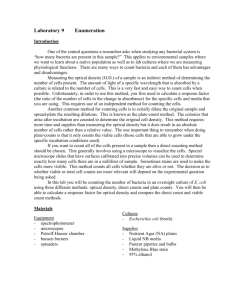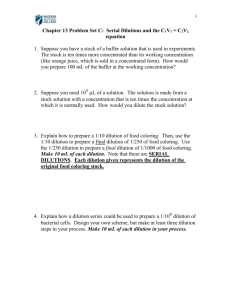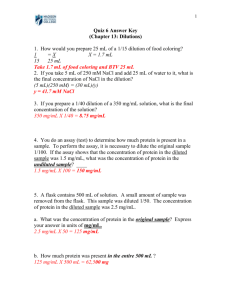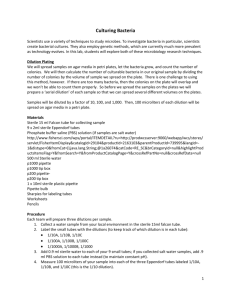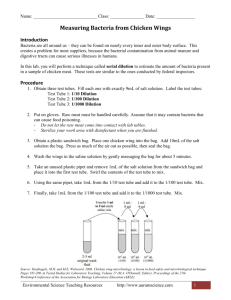This is one of the most common methods, for
advertisement
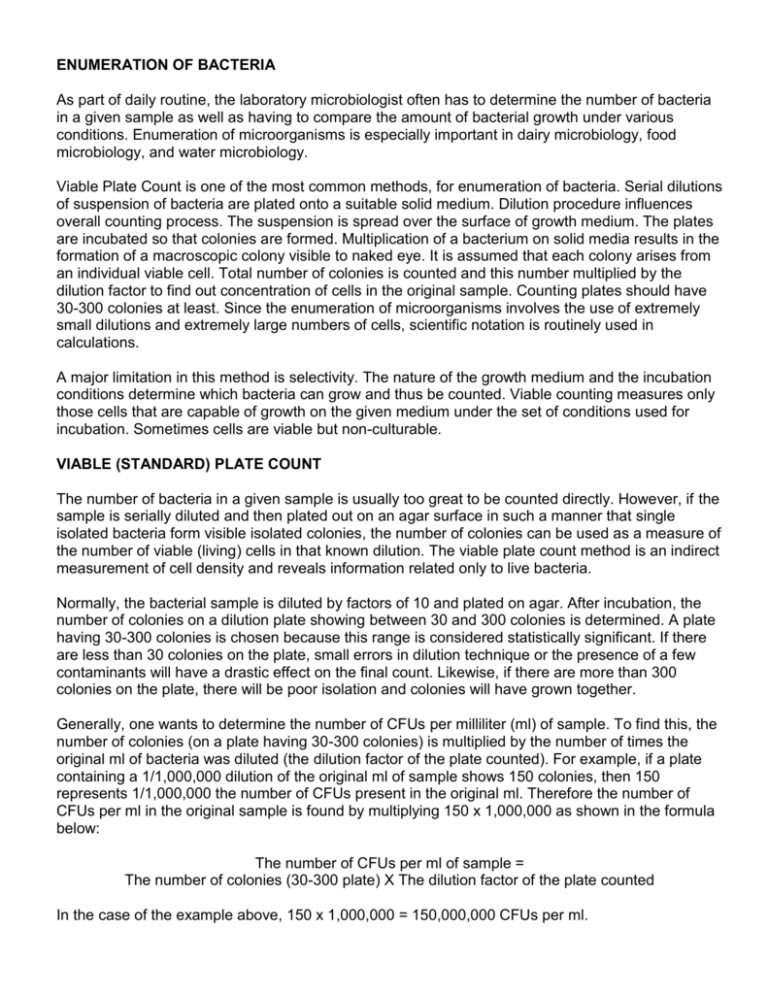
ENUMERATION OF BACTERIA As part of daily routine, the laboratory microbiologist often has to determine the number of bacteria in a given sample as well as having to compare the amount of bacterial growth under various conditions. Enumeration of microorganisms is especially important in dairy microbiology, food microbiology, and water microbiology. Viable Plate Count is one of the most common methods, for enumeration of bacteria. Serial dilutions of suspension of bacteria are plated onto a suitable solid medium. Dilution procedure influences overall counting process. The suspension is spread over the surface of growth medium. The plates are incubated so that colonies are formed. Multiplication of a bacterium on solid media results in the formation of a macroscopic colony visible to naked eye. It is assumed that each colony arises from an individual viable cell. Total number of colonies is counted and this number multiplied by the dilution factor to find out concentration of cells in the original sample. Counting plates should have 30-300 colonies at least. Since the enumeration of microorganisms involves the use of extremely small dilutions and extremely large numbers of cells, scientific notation is routinely used in calculations. A major limitation in this method is selectivity. The nature of the growth medium and the incubation conditions determine which bacteria can grow and thus be counted. Viable counting measures only those cells that are capable of growth on the given medium under the set of conditions used for incubation. Sometimes cells are viable but non-culturable. VIABLE (STANDARD) PLATE COUNT The number of bacteria in a given sample is usually too great to be counted directly. However, if the sample is serially diluted and then plated out on an agar surface in such a manner that single isolated bacteria form visible isolated colonies, the number of colonies can be used as a measure of the number of viable (living) cells in that known dilution. The viable plate count method is an indirect measurement of cell density and reveals information related only to live bacteria. Normally, the bacterial sample is diluted by factors of 10 and plated on agar. After incubation, the number of colonies on a dilution plate showing between 30 and 300 colonies is determined. A plate having 30-300 colonies is chosen because this range is considered statistically significant. If there are less than 30 colonies on the plate, small errors in dilution technique or the presence of a few contaminants will have a drastic effect on the final count. Likewise, if there are more than 300 colonies on the plate, there will be poor isolation and colonies will have grown together. Generally, one wants to determine the number of CFUs per milliliter (ml) of sample. To find this, the number of colonies (on a plate having 30-300 colonies) is multiplied by the number of times the original ml of bacteria was diluted (the dilution factor of the plate counted). For example, if a plate containing a 1/1,000,000 dilution of the original ml of sample shows 150 colonies, then 150 represents 1/1,000,000 the number of CFUs present in the original ml. Therefore the number of CFUs per ml in the original sample is found by multiplying 150 x 1,000,000 as shown in the formula below: The number of CFUs per ml of sample = The number of colonies (30-300 plate) X The dilution factor of the plate counted In the case of the example above, 150 x 1,000,000 = 150,000,000 CFUs per ml. At the end of the incubation period, select all of the petri plates containing between 30 and 300 colonies. Plates with more than 300 colonies cannot be counted and are designated too many to count (TMTC). Plates with fewer than 30 colonies are designated too few to count (TFTC). Count the colonies on each plate. DIRECT MICROSCOPIC CELL COUNT In the direct microscopic count, a counting chamber consisting of a ruled slide and a cover-slip is employed. It is constructed in such a manner that the cover-slip, slide, and ruled lines delimit a known volume. The number of bacteria in a small known volume is directly counted microscopically and the number of bacteria in the larger original sample is determined by extrapolation. The Petroff-Hausser counting chamber for example, has small etched squares 1/20 of a millimeter (mm) by 1/20 of a mm and is 1/50 of a mm deep. The volume of one small square therefore is 1/20,000 of a cubic mm or 1/20,000,000 of a cubic centimeter (cc). There are 16 small squares in the large double-lined squares that are actually counted, making the volume of a large double-lined square 1/1,250,000 cc. The normal procedure is to count the number of bacteria in five large double-lined squares and divide by five to get the average number of bacteria per large square. This number is then multiplied by 1,250,000 since the square holds a volume of 1/1,250,000 cc, to find the total number of organisms per cc in the original sample. If the bacteria are diluted, such as by mixing the bacteria with dye before being placed in the counting chamber, then this dilution must also be considered in the final calculations. The formula used for the direct microscopic count is: The number of bacteria per cc (ml) = The average number of bacteria per large double-lined square X The dilution factor of the large square (1,250,000) X The dilution factor of any dilutions made prior to placing the sample in the counting chamber TURBIDITY When you mix the bacteria growing in a liquid medium, the culture appears turbid. This is because a bacterial culture acts as a colloidal suspension that blocks and reflects light passing through the culture. Within limits, the light absorbed by the bacterial suspension will be directly proportional to the concentration of cells in the culture. By measuring the amount of light absorbed by a bacterial suspension, one can estimate and compare the number of bacteria present. Spectrophotometric analysis is based on turbidity and indirectly measures all bacteria (cell biomass), dead and alive. The instrument used to measure turbidity is a spectrophotometer. It consists of a light source, a filter which allows only a single wavelength of light to pass through, the sample tube containing the bacterial suspension, and a photocell that compares the amount of light coming through the tube with the total light entering the tube. The ability of the culture to block the light can be expressed as the amount of light absorbed in the tube. The absorbance (or optical density) is directly proportional to the cell concentration. (The greater the absorbance, the greater the number of bacteria.) A standard curve comparing absorbance to the number of bacteria can be made by plotting absorbance versus the number of bacteria per cc. Once the standard curve is completed, any dilution tube of that organism can be placed in a spectrophotometer and its absorbance read. Once the absorbance is determined, the standard curve can be used to determine the corresponding number of bacteria per cc. Increased turbidity in a culture is another index of bacterial growth and cell numbers (biomass). By using a spectrophotometer, the amount of transmitted light decreases as the cell population increases. The transmitted light is converted to electrical energy, and this is indicated on a galvanometer. The reading, called absorbance or optical density, indirectly reflects the number of bacteria. Light entering a cloudy solution will be absorbed. A clear solution will allow almost all of the light through. The amount of absorbance can be determined by using a spectrophotometer, which measures what fraction of the light passes through a given solution and indicates on the absorbance display the amount of light absorbed compared to that absorbed by a clear solution. Inside, a light shines through a filter (which can be adjusted by controlling the wavelength of light), then through the sample and onto a light-sensitive phototube. This produces an electrical current. The absorbance meter measures how much light has been blocked by the sample and thereby prevented from striking the phototube. A clear tube of water or other clear solution is the BLANK and has zero absorbance. The amount of substance in the solution is directly proportional to the absorbance reading. A graph of absorbance vs. concentration will produce a straight line. PROCEDURE PLATE COUNT 1. Take 6 dilution tubes, each containing 9 ml of sterile saline. Dilute 1 ml of a sample of E. coli as shown and described below. a. Withdraw 1 ml of the sample b. Dispense the 1 ml of sample into the tube by turning the filler knob away from you c. Using the same procedure, withdraw 1 ml from the first dilution tube and dispense into the second dilution tube. Continue doing this from tube to tube until the dilution is completed. 2. Transfer 0.1 ml from each of the last three dilution tubes onto the surface of the corresponding agar plates. (Note that since only 0.1 ml of the bacterial dilution rather than the desired 1 ml is placed on the plate, the actual dilution on the plate is 1/10 the dilution of the tube from which it came.) 3. Incubate the agar plates at 37°C for 48 hours. 5. Choose a plate that appears to have between 30 and 300 colonies. Sample 1/100,000 dilution plate. Sample 1/1,000,000 dilution plate. Sample 1/10,000,000 dilution plate. 6. Count the exact number of colonies on that plate using the colony counter 7. Calculate the number of CFUs per ml of original sample as follows: The number of CFUs per ml of sample = The number of colonies (30-300 plate) X The dilution factor of the plate counted ____________ = Number of colonies ____________ = Dilution factor of plate counted ____________ = Number of CFUs per ml PROCEDURE DIRECT MICROSCOPIC COUNT 1. Pipette 1 ml of the sample of E. coli into a tube containing 1 ml of the dye methylene blue. This gives a 1/2 dilution of the sample. 2. Fill the chamber of a Petroff-Hausser counting chamber with this 1/2 dilution. 3. Place a cover-slip over the chamber and focus on the squares using 400X. 4. Count the number of bacteria in 5 large double-lined squares. For those organisms on the lines, count those on the left and upper lines but not those on the right and lower lines. Divide this total number by 5 to find the average number of bacteria per large square. 5. Calculate the number of bacteria per cc as follows: The number of bacteria per cc (ml) = The average number of bacteria per large square X The dilution factor of the large square (1,250,000) X The dilution factor of any dilutions made prior to placing the sample in the counting chamber, such as mixing it with dye (2 in this case) The large, double-lined square holds a volume of 1/1,250,000 of a cubic centimeter. Using a microscope, the bacteria in the large square are counted. PROCEDURE TURBIDITY COUNT As the number of bacteria in a broth culture increases, the absorbance increases. 1. Put the ORIGINAL tube of E. coli and four tubes of the sterile broth in a test-tube rack. Each tube of broth contains 5 ml of sterile broth. Use four of these tubes (tubes 2 to 5) of broth to make four serial dilutions of the culture. 2. Transfer 5ml of E. coli to the first broth tube. Transfer 5ml from that tube to the next tube, and so on until the last of the 4 tubes has 5ml added to it. These tubes will be 1/2, 1/4, 1/8, and 1/16 dilutions. a. Standardize the spectrophotometer by using a BLANK. The BLANK used to standardize the machine is sterile nutrient broth: it is called the BLANK because it has a sample concentration equal to zero. b. Place the original bacterial specimen into the spectrophotometer. Next insert the 1/2 dilution and read it. Repeat this with the 1/4, 1/8, and 1/16 dilutions. Read to the nearest thousandth (0.001) on the absorbance digital display. c. Record your values, along with the dilutions that they came from. Using the standard curve table, calculate the number of bacteria per milliliter for each dilution. DATA TABLE TURBIDITY COUNT Dilutions Absorbance (X) # of Bacteria (Y) Original E. coli 1/2 1/4 1/8 1/16 1. Fill in your absorbance values for the 5 tubes read in the spectrophotometer. 2. Calculate the number of bacteria in the original tube of E. coli, and place that value in the top right cell of the table. 3. Calculate the approximate numbers of bacteria in the 1/2, 1/4, 1/8, and 1/16 by halving the number in the cell above. DISCUSSION 1. State the formula for determining the number of CFUs per ml of sample when using the plate count technique. 2. State the formula for determining the number of bacteria per cc of sample when using the direct microscopic method of enumeration. 3. State the relationship between absorbance (optical density) and the number of bacteria in a broth sample. USE OF THE SPECTROPHOTOMETER 1) Set the display mode to ABSORBANCE by pressing the MODE control key until the appropriate red LED is lit. 2) Set the wavelength to 520 nm by using the WAVELENGTH dial. 3) Fill an empty tube with 1ml of broth to serve as the BLANK. 4) With the right-hand knob, adjust the display to read zero ABSORBANCE. 5) Read the absorbance value directly from the digital display.

